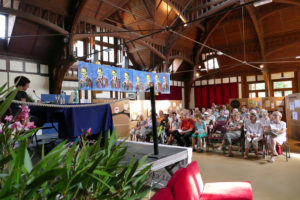Dr Nina Rolland, New Research Associate on the Baudelaire Song Project reports on the Symposium on Baudelaire, Berg and Debussy at the Oxford Lieder Festival 2017.
This year the Oxford Lieder Festival focussed on the figure of Mahler as ‘The last of the Romantics’, but this epithet could as well refer to Baudelaire: Is Baudelaire the last of the Romantic French poets? What influences shaped the culture of the late or post-Romantics as new musical and poetic languages started to develop? These are some of the questions Helen Abbott, Caroline Potter and Caroline Ardrey raised in a symposium on 19 October in Oxford.

The morning session ‘Pretty Women: Baudelaire with Berg’ gave some insights into the connections between Baudelaire and Alban Berg via the German translation of Stefan George. One of the key links between Baudelaire and Berg is the way they were both inspired by the Romantic tension between real and idealised versions of women. For Baudelaire, Jeanne Duval, Marie Daubrun and Mme Sabatier were sources of inspiration while for Berg, it was Hanna Fuchs. The Austrian composer wrote his Lyric Suite (1926) for her, working coded references to her name into his 12-note series. Berg also alluded to the German translation of Baudelaire’s ‘De profundis clamavi’ in his Lyric Suite, further emphasising the theme of unattainable love.
After an enchanting lunchtime recital with Sophie Karthäuser (Soprano), Eugene Asti (piano), and the Doric Quartet performing Berg’s Lyric Suite and Debussy’s Cinq Poèmes de Baudelaire, the afternoon session ‘Being à la mode Baudelaire with Debussy’ contextualised the chain of relations between both artists in fin-de-siècle Paris. The links between Baudelaire and Debussy can be widely traced back through the rich artistic networks which evolved in bookshops and salons, through Debussy’s publishing history, as well as through fashion artefacts and visual arts. Indeed, fashion itself offers up an intriguing link between poetry and music within Debussy’s oeuvre: his contemporary, the poet Stéphane Mallarmé used ephemera and trinkets from everyday life and society as inspiration for his poems, and even used decorative objects – including fans – as a surface on which to write poetry. Debussy engaged with Mallarmé’s poetry in varied ways, setting to music three of Mallarmé’s poems including his “Eventail de Madame Mallarmé” (Fan for Madame Mallarmé).

To respond to the interactive sessions in an original way, the Oxford Lieder audience was asked to write or draw, à la mode de Mallarmé, on fans! The audience enthusiastically got stuck in, writing poems, ideas and reactions to the day on fans bringing forth a fantastic variety of (aesthetically pleasing!) responses and showing how poetry can be a source of inspiration across all kinds of different media and artistic forms.









